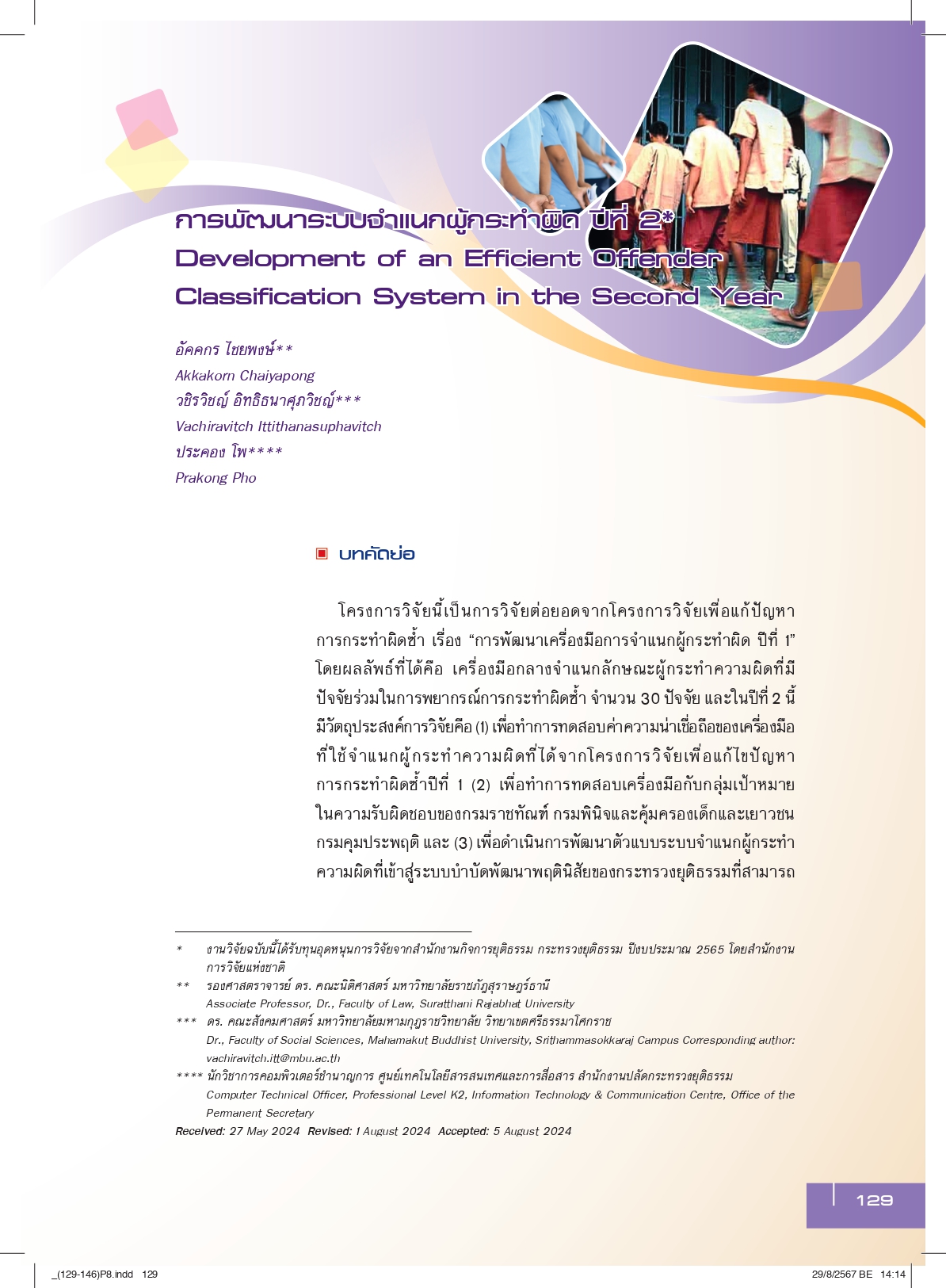Development of an Efficient Offender Classification System in the Second Year
Main Article Content
Abstract
The research project is extended from the project of solving for recidivism, which is based on the research titled “Development of the tool for classifying the offender in the first year". A tool for classifying offenders with 30 common factors responsible for forecasting repetitive offenses was developed. Consequently, the research in the second year aims to (1) test the reliability of the research tool for offender classification obtained from the research project on solving for recidivism in the first year; (2) trial the research tools for the target group under the responsibility of the Department of Corrections, the Department of Juvenile Observation and Protection, and the Department of Probation and Office of the Permanent Secretary for Justice; and (3) develop a model of the classification system that is efficiently capable of classifying risks and needs in habit rehabilitation to prevent and solve the recidivism problem for the offender who entered the Ministry of Justice’s behavior development therapy system. Documentary research was applied in this study, whereas the focus group and an in-depth interview were utilized as research tools. Moreover, the data were analyzed via a predictive model using artificial intelligence (AI) in the field of machine learning. The massive data from the database of the Ministry of Justice (MOJ Data Lake) from 2017-2021, with 2,035,991 sets in total, were subsequently cleaned into 1,384,998 sets. Then, they were analyzed to obtain the values of accuracy as well as the factors that influence the offender classification.
According to the research findings, (1) the test for the reliability of the research tool for offender classification obtained from the first-year research project yielded 28 variables with appropriateness over 50%. There is 1 variable with 50% appropriateness and 1 variable with appropriateness below 50%. With respect to the reliability of the tools for classifying the offenders by score value, it appeared that there were 7 variables with “the highest” score, 18 variables with “high” score, and 5 variables with “medium” score. (2) On the basis of the trial of research tools on targets under the Department of Corrections, the Department of Juvenile Observation and Protection, and the Department of Probation and Office of the Permanent Secretary for Justice, the offender classification from the Department of Corrections exhibited 16 variables. The Department of Juvenile Observation and Protection engaged 21 variables, whereas the Department of Probation employed 22 variables for the classification. Moreover, (3) the model of the classification system for offenders who entered the behavior development therapy system of the Ministry of Justice established 3 models in total according to each mentioned department. The accuracy test after adjusting the model yielded 80.07% for the Department of Juvenile Observation and Protection, 85.03% for the Department of Probation, and 94.25% for the Department of Corrections.
Article Details

This work is licensed under a Creative Commons Attribution-NonCommercial-NoDerivatives 4.0 International License.
Published Manuscripts are the copyright of the Journal of the Justice System. However; the opinions that appeared in the content are the sole responsibility of the author.
References
Andrews, D., & Bonta, J. (2010). The psychology of criminal conduct (5th ed.). LexisNexis Matthew Bender.
Data EXchange Center. (2024, June 15). The number of recidivisms classified by agency. Tableau Public.
https://public.tableau.com/app/profile/nswj/viz/12254/BI01-01-00.
Digital Government Development Agency (Public Organization) (DGA). (2022, September 27). Data quality. https://www.dga.or.th/frontpage/.
Hilterman, E.L.B., Nicholls, T.L., and Nieuwenhuizen, C. (2014). Predicting validity of risk assessments in juvenile offenders: Comparing the SAVRY, PCL: YV, and YLS/CMI with unstructured clinical assessments. Assessment, 21(3), 324-339.
Jones, N. J., Brown, S. L., Robinson, D., & Frey, D. (2016). Validity of the youth assessment and screening instrument: A juvenile justice tool incorporating risks, needs, and strengths. Law and Human Behavior, 40(2), 182-194.
National Statistical Office. (2022, September 27). Completeness. http://service.nso.go.th/nso/nsopublish/know/estat1.html
National Science and Technology Development Agency. (2022, September 16). Data standard. https://www.nstda.or.th/en/
Office of Justice Affair. (2024, June 15). Updating Thai Criminal Justice 2022. https://www.oja.go.th/wp-content/uploads/2023/09/updating-thai-criminal-justice-2022-new.pdf
Ratchakitcha. (2023, June 1). Announcement of the Digital government development committee subject: Good governance of government data. https://www.ratchakitcha.soc.go.th/DATA/PDF/2563/E/074/T_0047.PDF
Teera Sindecharak et al. (2020). Development of an offender classification tool. Office of Justice Affair.
Veenunkarn Rujiprak, Nunrapat Chaiakkapong and Krisda Saengcharoensap. (2021). The development of risk and need assessments for juvenile rehabilitation in Juvenile Detention Center. Department of Juvenile Observation and Protection.


